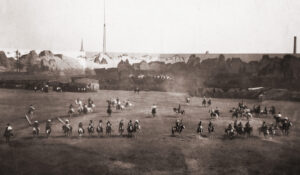Dodge City: The Early Years, 1872–1886
by Wm. B. Shillingberg, The Arthur H. Clark Company, Norman, Okla., 2009, $49.95.
“The buildings were mostly box affairs and built in the quickest possible way,” buffalo hunter Billy Dixon recalled of early Dodge City, Kansas. “But a palace does not make happiness, and I am sure that in the rough, frontier towns of those days there was lots of contentment and good cheer in the rudest shacks.” Arguably Kansas’ most famous cattle town, Dodge City was much more than that, historian Wm. B. Shillingberg writes, and those rough buildings weren’t always full of contentment and good cheer.
Dodge City, of course, has been well chronicled before, in books like Stanley Vestal’s Queen of Cowtowns (1952) and Fredric R. Young’s Dodge City: Up Through a Century in Story and Pictures (1972) and in the myriad books detailing cattle trails and Kansas cow towns. Yet Shillingberg goes beyond the myth, relying on wealth of primary sources to produce a lively, fascinating read about how a town grows and transforms, as well as the politics and personalities front and center.
Dodge City grew from the rough buffalo hunting community Dixon saw to become main shipping point of Texas Longhorns, and its reputation grew with it. The national press loved ripping the city, as illustrated by this note from The Washington Evening Star: “Dodge City is a wicked little town. Indeed its character is so clearly and egregiously bad that one might conclude—were the evidence in these latter times positive of its possibility—that it was marked for special Providential punishment.”
Dodge City did not really settle down and lose most of its frontier warts until after the trail drives ended, around 1886. By the 1900s, Shillingberg writes, “The celebrated romance of the frontier was replaced by reality. Dodge City became civilized—somehow sadly ordinary.”
Originally published in the February 2010 issue of Wild West. To subscribe, click here.




